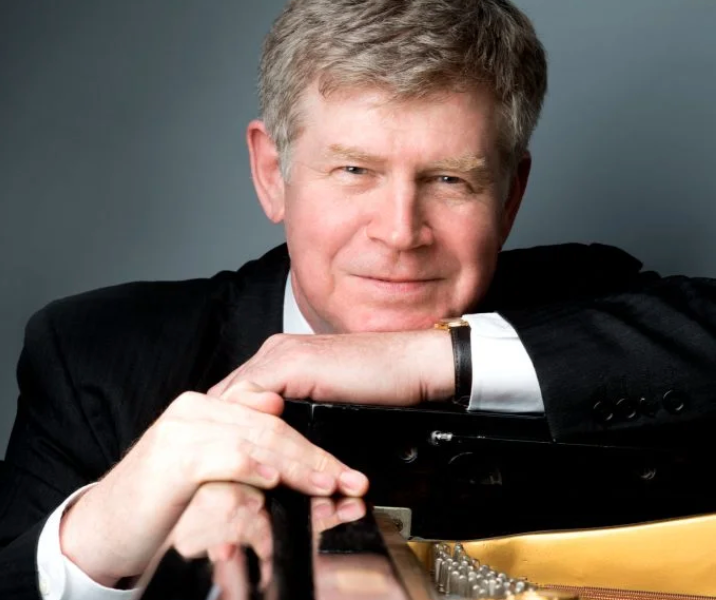Ian Hobson and Friends: Schumann for Three, Four and Five in Review
Ian Hobson, piano; Andrés Cárdenes, violin; Jun Iwasaki, violin; Csaba Erdélyi, viola; Ko Iwasaki, cello
Tenri Cultural institute, New York, NY
May 10, 2024
The energy was buzzing tonight at the Tenri Cultural Institute – pianist Ian Hobson is back this evening and has once again curated a program of works by composer Robert Schumann, this time featuring exciting chamber works. The house was packed, and the supportive audience was in for a thrilling performance.
The program started with a piano trio titled Phantasiestüke, Op. 88, which featured violinist Jun Iwasaki and cellist Ko Iwasaki. This work, the latest of the three works performed tonight, dates back to 1842, during his chamber music period, but underwent revisions over the years before being published in 1850. Interestingly, the title “Fantasy pieces” is also used for a solo piano work predating this trio.
These brief movements were delightful. The opening movement, Romance, captivated the listeners with its seductive melody and nostalgic undertones. Mr. Hobson skillfully projected Schumann’s introspective melodies, met with responsive interplay from the strings as they intertwined with the piano, which assumed a protagonist role.
In the second movement, Humoreske, the trio starts with rhythmic unison, gradually unfolding into a canonic section. The trio’s sound was robust, maintaining a healthy pulse throughout. Especially noteworthy was the expansive B-section, offering significant contrast, which the trio conveyed generously. The subsequent section surged with ecstatic energy, and the return to the A-section felt invigoratingly fresh.
The third movement, Duett for violin and cello, was poignant. The featured soloists, Jun Iwasaki and Ko Iwasaki played with intimate tenderness and seamless communication. Transitioning to the contrasting fourth movement, Finale, began with a march. However, some of the contrasting sections felt somewhat long-winded, a quality in Schumann that can be a challenge to overcome.
The next piece on the program was the Piano Quartet in E-flat major, Op. 47. This four-movement work featured guest artists Andrés Cárdenes (violin), Csaba Erdélyi (viola), and Ko Iwasaki (cello). The piece begins with a slow introduction (Sostenuto assai), which then transitions to a faster section (Allegro ma non troppo). The performers captured the melancholy of the opening and the improvisatory nature of the faster Allegro, and showcased thoughtful exchange among the instruments. The second movement, Scherzo: Molto vivace – Trio I – Trio II, was dynamic, finely balanced, and imbued with a light character. Moving to the third movement, Andante cantabile, it featured one of Schumann’s most tuneful and emotionally resonant themes. Each member of the ensemble demonstrated a profound affection for this melody, infusing it with deep sentiment every time it recurred. Particularly noteworthy was the viola solo performed by Mr. Erdélyi and the delicate conclusion added to the overall charm of the performance. The concluding movement, Finale: vivace, was overflowing with energy, with its fugal entries even evoking memories of Mr. Hobson’s previous performance, Counterpoints. The ensemble exhibited excellent communication and demonstrated a keen understanding of Schumann’s adept transitions from Baroque elements to Romanticism within the piece—a skill finely executed.
The only work on the second half of tonight’s program was the Piano Quintet in E-flat major, Op. 44 – arguably Schumann’s most beloved and well-known chamber work. The exciting first movement, Allegro brilliante, was compelling and performed with gusto. However, during the development section, there was a sense of tentativeness, and an overall heaviness in the pulse made it feel as if it was somewhat dragging.
This work, with its cyclical elements, continues by having the piano lead in to the second movement, In modo d’un marcia, un poco largamente. This somber and austere funeral march was characterized by its placed silences and well-articulated short phrases shared by each member of the ensemble. The contrasting B-section was angelic and revealed a transparent beauty while the tragic C-section was highlighted by dramatic outbursts. The bleak march returns, but this time more fragmented and wearier before ending with a haunting pianissimo chord.
The virtuosic third movement, Scherzo: Molto vivace – Trio I – Trio II, is driven by ascending scales, which the musicians executed with precision and buoyancy, maintaining a consistent pulse without allowing it to falter or accelerate excessively. After a transition to Trio I, defined by a frenetic dance pulse, the ensemble seamlessly returned to the impetuous scale motif, showcasing their command of the composition’s constant rhythmic shifts.
The last movement, Allegro man non troppo, feels almost regal and within it encapsulates the entire work. Its main theme, skeletal yet rhythmically dynamic, harkens back to the world of the first movement. Moreover, the contrasting episodes, built upon the same thematic material, establish a sense of unity in diverse forms. As the main theme from the first movement returns in its fugal state, the ensemble effectively paced this concluding section, heightening the excitement and fervent quality to the forefront – so much so that when the final chords sounded, the audience rose to their feet in applause.
It was a pleasure to hear this fine program at the hands of passionate and giving musicians who are clearly expert chamber music collaborators!
by Walter Aparicio for New York Concert Review; New York, NY

